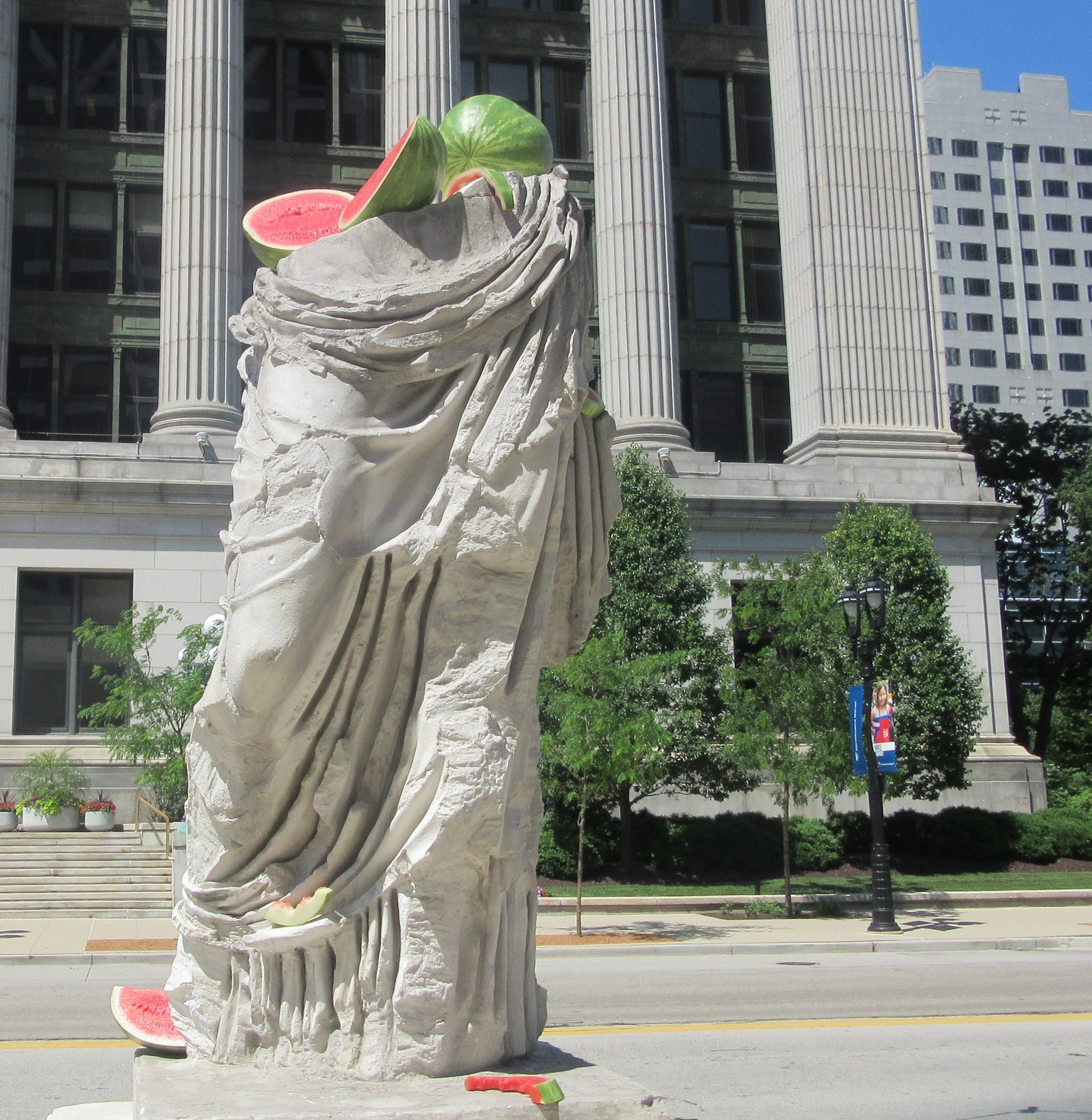One of the more complex and fraught cultural issues arising these days is the removal of (largely) Confederate statues. Some are being toppled and at least partly destroyed. I’m all for the long-overdue change in culture, in response to our urgent times. This need is no better addressed than in this recent Op-Ed by poet and author Caroline Randall Williams in The New York Times, powerfully underscored in a dark symbolism, dwelling in the statues’ heroic posturings. Here (via Daily Kos) is a link: NYT Op-Ed on Confederate statues
The Times headline defiantly declared “You Want a Confederate Monument? My Body is a Confederate Monument.”
Williams continued with the startling lead:
I have rape-colored skin. My light-brown-blackness is a living testament to the rules, the practices, the causes of the Old South.
She went on to explain:
I am a black, Southern woman, and of my immediate white male ancestors, all of them were rapists…
 Poet and author Caroline Randall Williams wrote a scathing commentary recently on the dark underbelly of Confederate statues for The New York Times. Courtesy Nashville Scene.
Poet and author Caroline Randall Williams wrote a scathing commentary recently on the dark underbelly of Confederate statues for The New York Times. Courtesy Nashville Scene.
Amen to that. However, I’m also in the camp of those who think Confederate statues should be moved to museums, and submitted to proper historical contextualization and commentary. And partly given my undergrad degree was in art, with a concentration on sculpture, I have a bias towards preserving public art of historical significance, the good, bad and sometimes even the ugly..
The issue reached a razor’s edge that bled into the absurd recently in Madison, Wisconsin, where I lived and worked for nearly 20 years, as an arts reporter for The Capital Times. So I was greatly saddened see that Wisconsin’s “foreword” statue, long situated on the Capitol Square, was knocked over, and thrown in Lake Mendota. And that the statue of renowned abolitionist and union soldier Hans Christian Heg – a Norwegian immigrant who knew the meaning of being an other, and who died fighting to end slavery – was knocked down and dragged down the street. These were acts of little more than self-righteous ignorance, or worse, perhaps racist subversion.
Several of my friends suspect this was the handiwork of a Neo-Nazis or White Supremacists infiltrating the Madison George Floyd civil rights protests. As one friend shrewdly observed, the guilty party scrawled the phrase “BLACK IS BEAUTIFUL” at the top of the deposed Heg sculpture’s base (see below). Here’s the thing. That phrase hasn’t been used by most African-Americans since the 1960s. It suggests this was a bogus and culturally lame attempt to place the blame on Black Lives Matter.

Base of the statue of abolitionist Hans Christian Heg in Madison, after the statue was torn down recently. Photo by Allison Garfield. Courtesy Milwaukee Journal-Sentinel.
On a related issue, I cannot agree with student activists who call for the removal of the beloved statue of a seated Abraham Lincoln, at the top of Bascom Hill on the UW-Madison campus. The bronze sculpture mirrors the grand marble sculpture of our 16th president seated in The Lincoln Memorial.
The controversy has to do with what we now call white supremacist comments that Lincoln made before the Civil War during the famous debates with Stephen Douglas. Yes, they are troubling, but history shows that Lincoln redeemed himself through his actions many times over, and indeed was a martyr for the cause of ending slavery. He inspired Juneteenth Day with his Emancipation Proclamation, which freed all slaves.
Such a leader should be judged by his actions, and such formal proclamations that carry great political weight, rather than by his worst comments, which reveal his racial biases (which we all have, to some degree). Remember too, it was the 1850s, upon which we can misapply our social standards begat by time. We know Lincoln realized that even he struggled at times to stay aligned with the better angels of his nature. And that he always considered slavery immoral and worth destroying with all the Union’s might.
As for what to do about politically historical statues in general, I prefer to think more constructively. If we replace Confederate statues, what should we commission or construct in their stead?
The issue of how to replace them was addressed creatively by six artists in a 2018 New York Times article, when the controversy over a Robert E. Lee statue arose in connection to the infamous Charlottesville clash of civil rights and white supremacists: The New York Times, Aug. 10, 2018, “Monuments for a New Era.”
But Madison and other cities could follow the example of Milwaukee, which last December purchased a bronze sculpture by the acclaimed black sculptor Radcliffe Bailey depicting W.E.B. DuBois, the great black writer, thinker, sociologist and civil rights activist. 1 The sculpture, titled “Pensive,” depicts DuBois seated in the same posture as Auguste Rodin’s celebrated “The Thinker,” and even mimics the early modernist Rodin’s rough-hewn modeling. The work was purchased as a gift to the city by Sue and Mark Irgens, and mounted this spring in its new location outside of the new BMO Tower, 790 N. Water St.

Radcliffe Bailey, Pensive, 2013, part of Sculpture Milwaukee 2019. © Radcliffe Bailey, Courtesy the artist and Jack Shainman Gallery, New York. Photo by Kevin J. Miyazaki for Sculpture Milwaukee
Milwaukee first experienced the quiet but indeed pensive power of the bronze figure in the 2019 MKE Sculpture exhibit mounted along Wisconsin Avenue. For me, it was the outstanding work in the exhibit, artistically and culturally, and I spotlit it in a blog posting, here:
Bronze sculpture of W.E.B. DuBois is highlight of Sculpture Milwaukee
The work’s conceptual lineage is deep, as Rodin’s original “The Thinker” depicted poet Dante Aligieri’s figure, drawing from the poet’s The Divine Comedy, and conceived as a figure contemplating Rodin’s massive tableaux sculpture, The Gates of Hell commissioned in 1880. The symbolic significance of the tableaux is not lost on our times, nor on DuBois’s, when he boldly stirred American consciousness on matters of race in the early 20th century, directly defying Jim Crow.
But the first of Rodin’s familiar monumental bronze castings of “The Thinker,” as a stand-alone sculpture, did not appear until 1904.
Works such as Bailey’s, completely in 2013, ought to be the standard we strive for in public art, especially on fraught matters as race relations or the Civil War. I would love to see Madison commission or purchase a monument to, say, the epic ex-slave biographer and leader Frederick Douglass, or the heroic Underground Railroad operator Harriet Tubman, or modern civil rights pioneer Rosa Parks. Or even a work commemorating the death of Emmett Till, which sparked the modern civil rights movement, sensitive as such a rendering might be.
We are in a time of extraordinary social upheaval and transformation, which may feel to too transitory for doubters of social progress. Still, I can think of few better ways we can celebrate such progress and permanently inspire its furtherance, than with bronze public sculptures that embody our history’s embattled nobility and, we pray, our future redemption in freedom and equality for all.
___________
1 News of the sculpture’s purchase, gifting and re-installation, as reported by Bobby Tanzilo of OnMilwaukee.com: https://onmilwaukee.com/ent/articles/irgens-pensive.html
Like this:
Like Loading...






 In Ralph Peterson and the Messenger Legacy, trumpeter Brian Lynch revisits his front-line fellows, Bobby Watson (left) and Billy Pierce (right), from the final edition of Art Blakey and the Jazz Messengers. Photo courtesy jimmysoncongress.com
In Ralph Peterson and the Messenger Legacy, trumpeter Brian Lynch revisits his front-line fellows, Bobby Watson (left) and Billy Pierce (right), from the final edition of Art Blakey and the Jazz Messengers. Photo courtesy jimmysoncongress.com
 Poet and author Caroline Randall Williams wrote a scathing commentary recently on the dark underbelly of Confederate statues for The New York Times. Courtesy Nashville Scene.
Poet and author Caroline Randall Williams wrote a scathing commentary recently on the dark underbelly of Confederate statues for The New York Times. Courtesy Nashville Scene.





